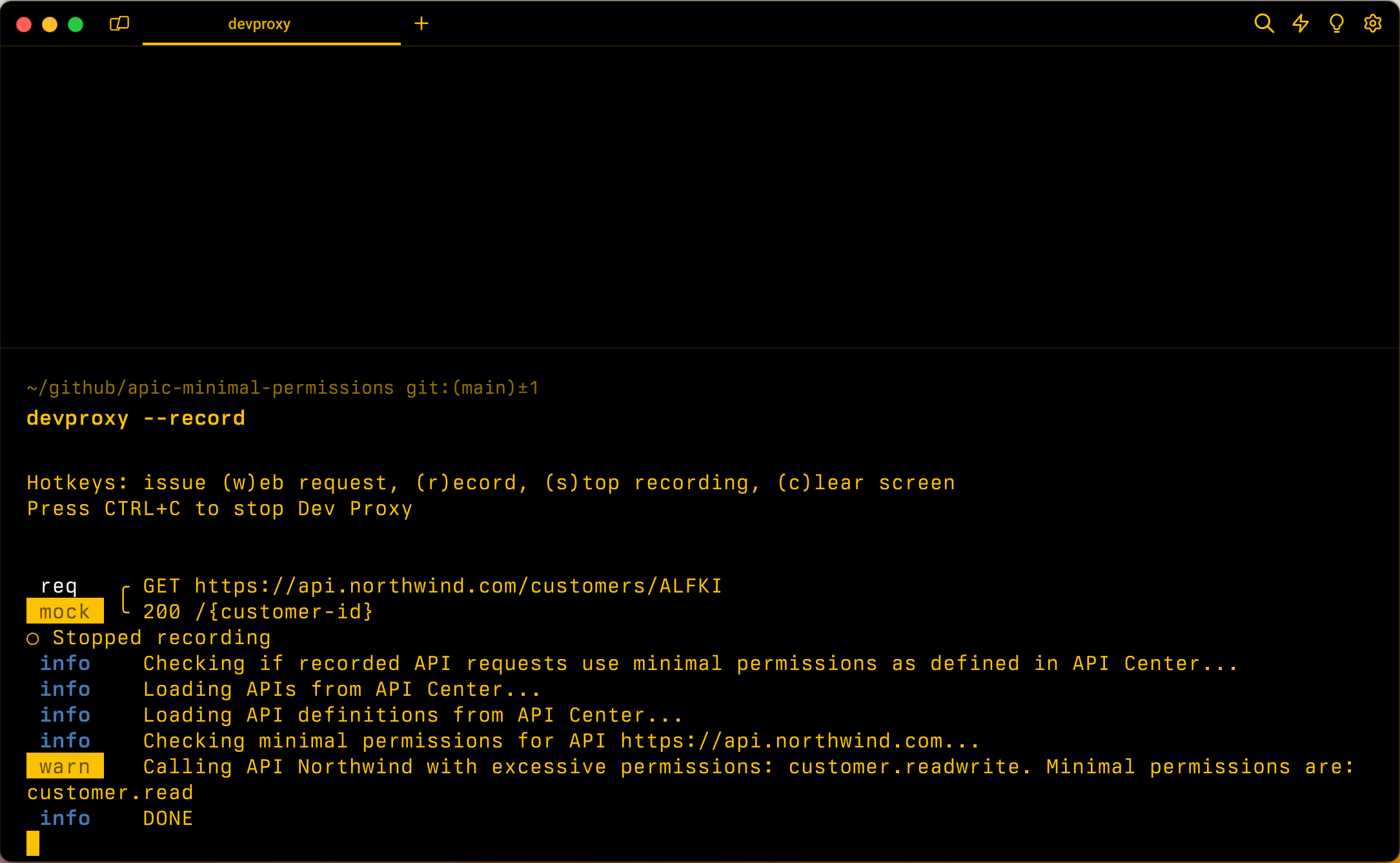ApiCenterMinimalPermissionsPlugin
Checks if the app uses minimal permissions to call APIs. Uses API information from the specified Azure API Center instance.
Plugin instance definition
{
"name": "ApiCenterMinimalPermissionsPlugin",
"enabled": true,
"pluginPath": "~appFolder/plugins/dev-proxy-plugins.dll",
"configSection": "apiCenterMinimalPermissionsPlugin"
}
Configuration example
{
"apiCenterMinimalPermissionsPlugin": {
"subscriptionId": "aaaa0a0a-bb1b-cc2c-dd3d-eeeeee4e4e4e",
"resourceGroupName": "resource-group-name",
"serviceName": "apic-instance",
"workspaceName": "default"
}
}
Configuration properties
| Property | Description | Default |
|---|---|---|
resourceGroupName |
Name of the resource group where the Azure API Center is located. | None |
serviceName |
Name of the Azure API Center instance that Dev Proxy should use to check if the APIs used in the app are registered. | None |
subscriptionId |
ID of the Azure subscription where the Azure API Center instance is located. | None |
workspace |
Name of the Azure API Center workspace to use. | default |
Command line options
None
Remarks
The ApiCenterMinimalPermissionsPlugin plugin checks if the app uses minimal permissions to call APIs. To check permissions, the plugin uses information about APIs that are registered in the specified Azure API Center instance.
Connect to Azure API Center
To connect to Azure API Center, the plugin uses Azure credentials (in this order):
- Environment
- Workload Identity
- Managed Identity
- Visual Studio
- Visual Studio Code
- Azure CLI
- Azure PowerShell
- Azure Developer CLI
If the plugin fails to get an access token to access Azure, it shows an error and Dev Proxy disables it. Sign in to Azure using either of these tools, and restart Dev Proxy to use the ApiCenterMinimalPermissionsPlugin plugin.
If you use Dev Proxy in CI/CD pipelines, you can pass values for the subscriptionId, resourceGroupName, serviceName, and workspaceName properties as environment variables. To use environment variables, prepend the name of the value with a @, for example:
{
"apiCenterMinimalPermissionsPlugin": {
"subscriptionId": "@AZURE_SUBSCRIPTION_ID",
"resourceGroupName": "@AZURE_RESOURCE_GROUP_NAME",
"serviceName": "@AZURE_APIC_INSTANCE_NAME",
"workspaceName": "@AZURE_APIC_WORKSPACE_NAME"
}
}
In this example, the ApiCenterMinimalPermissionsPlugin plugin sets subscriptionId, resourceGroupName, serviceName, and workspaceName properties to the values of the AZURE_SUBSCRIPTION_ID, AZURE_RESOURCE_GROUP_NAME, AZURE_APIC_INSTANCE_NAME, and AZURE_APIC_WORKSPACE_NAME environment variables, respectively.
Define API permissions
The ApiCenterMinimalPermissionsPlugin plugin supports checking OAuth permissions for APIs secured with OAuth registered in Azure API Center. The plugin computes the minimal permissions required to call the APIs used in the app using the information from API Center. Then, the plugin compares the permissions used in the JSON Web Token (JWT) token against the minimum required scopes needed for the requests that Dev Proxy recorded.
To define permissions for your APIs, include them in the OpenAPI definition of your API. The following example shows how to define permissions for an API in an OpenAPI definition:
{
"openapi": "3.0.1",
"info": {
"title": "Northwind API",
"description": "Northwind API",
"version": "v1.0"
},
"servers": [
{
"url": "https://api.northwind.com"
}
],
"components": {
"securitySchemes": {
"OAuth2": {
"type": "oauth2",
"flows": {
"authorizationCode": {
"authorizationUrl": "https://login.microsoftonline.com/common/oauth2/authorize",
"tokenUrl": "https://login.microsoftonline.com/common/oauth2/token",
"scopes": {
"customer.read": "Grants access to ready customer info",
"customer.readwrite": "Grants access to read and write customer info"
}
}
}
}
},
"schemas": {
"Customer": {
"type": "object",
// [...] trimmed for brevity
}
}
},
"paths": {
"/customers/{customers-id}": {
"description": "Provides operations to manage a customer",
"get": {
"summary": "Get customer by ID",
"operationId": "getCustomerById",
"security": [
{
"OAuth2": [
"customer.read"
]
},
{
"OAuth2": [
"customer.readwrite"
]
}
],
"responses": {
"200": {
"description": "OK",
"content": {
"application/json; charset=utf-8": {
"schema": {
"$ref": "#/components/schemas/Customer"
}
}
}
}
}
},
"patch": {
"summary": "Update customer by ID",
"operationId": "updateCustomerById",
"security": [
{
"OAuth2": [
"customer.readwrite"
]
}
],
"requestBody": {
"required": true,
"content": {
"application/json": {
"schema": {
"$ref": "#/components/schemas/Customer"
}
}
}
},
"responses": {
"204": {
"description": "No Content"
}
}
},
"parameters": [
{
"name": "customers-id",
"in": "path",
"required": true,
"schema": {
"type": "string"
}
}
]
}
},
"x-ms-generated-by": {
"toolName": "Dev Proxy",
"toolVersion": "0.19.0"
}
}
The relevant part is the securitySchemes section, where you define the OAuth scopes that the API uses. Then, for each operation, you include the required scopes in the security section.
